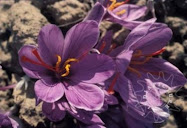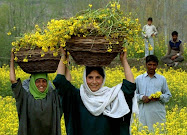
Coming first Nauratra (April 27) is a special day for KP's. It's NAVREH (New Year Day) in Kashmir. The first day of Saptrishi Samvat of the lunar year is celebrated as New Year by Kashmir Pandits. It's also the Basant or Sounth in Kashmiri. It is celebrated on Chaitra Shukla Pakhsh Pratipada. It’s said on this momentous festival Lord Brahma created the whole universe. On this day the new almanac, the annual calendar with new astronomical data and lot of other information commences for the new Hindu calendar year. With this day the most soothing season of the year, the spring starts with a renewed life. The nature wears a new look. Fresh fragrance of new flowers and blossoms fill the air immediately after snow melts in Kashmir. The notes of early migratory birds, Poshnool, Phambseer, Cheni-Hagur, Katij, Kukil, Sheene-Pipien etc are heard after a long spell of winter.
Navreh is also a celebration of an escape from the clutches of the severe cold of winter with a new lease of life and a season of regeneration and fertility. Prior to the festival the family Brahmin brings in the new almanac (Panchang) of the New Year, called Janthari or Nechepater in Kashmiri. In olden days the family Brahmin brought in a beautifully designed handmade scroll of paper with paintings of Goddess Saraswati and Sharika along with a brief calendar of the year showing dates of various important days and festivals called Kreel-Patch but with the advent of the detailed Panchang (Janthari) started in early twentieth century the handmade Kreel-Patch got discouraged.
On the night prior to Navreh the eldest lady of the house fills a big plate (Thali) with uncooked rice and arranges various items on it. The new Janthari occupies an important place with a twig of fresh seasonal flowers, some coins, walnuts (three, five or seven), a small mirror, a Katori filled with Yoghurt, a pinch of salt, a lump of cooked rice, a pen with an inkpot, a golden ornament (a ring or a bangle), a piece of bread or Kulcha etc as per the family traditions are placed on this rice filled Thali. The ritual is called ‘Thal Barun’. On the early morning of Navreh before sunrise all family members have a Darshan of all this Thali with all the items placed on it and look their faces especially in the mirror and the ritual is called ‘Buth-Vuchun’.
All the things arranged on the rice filled Thali have a special significance. The rice being the principal diet of Kashmiris guarantees abundance, the walnuts ensure regeneration and stability, coins and gold ornament prosperity, the pen and inkpot education, wisdom and knowledge, curds fullness and stability. Seeing one’s face in the mirror on the early morning of Navreh dispels all evil influences if present in the house and guarantee a carefree time ahead. The walnuts are thrown into the flowing water and the rice used for making a yellow cooked rice called Taher and is taken as Prasad.
In good olden days before 1990 the Pandits of Srinagar city after having an early bath on Navreh morning and putting in new clothes would proceed in large numbers to Hari-Parbat hill, the nearby most auspicious Teertha of Kashmir to pay obeisance to the thousands of deities especially Maa Sharika and Chakrishur on the hilltop. Maa Sharika is the presiding deity of Srinagar. The holy ‘Devi-Aangan’ at the foothill of Hari-Parbat is the holiest of the holy spots for meditation for spiritual awakening.
The Pandits in Srinagar also used to enjoy the fresh almond blossom in Badam-Vaari in the foothills of Hari-Parbat on this day. It was a wonderful picnic spot and lots of people gathered there in the season, sat on ground on the freshly grown greenery and enjoyed hot sips of Kehwa, a local tea without milk from Samavaar, a peculiar Kashmir tea kettle with an arrangement of heating up with burning charcoal kept inside. There used to be an occasional arrangement of music presentations in Badaam-Wari where traditional Kashmiri Chakri was arranged by various master artists of Kashmir. Now everything has changed after the exodus of Pandits from the valley. There is a permanent scare of armed millitants in the air and general public of all hues prefers to remain away from such so-called extravaganza....... (to be continued)
.jpg)




It was enlightening to know about the festivities which accompany Navreh.I am curious to know the significance of throwing the walnuts into flowing water.And now I understand how difficult it is to continue these celebrations without being in the cradle of Kashmir.
ReplyDeleteI am glad to know about the importance of Navreh and the things present in thali. Like Shalini i have same doubt about the significance of throwing the walnuts into flowing water.
ReplyDeleteI'm myself unaware of the significance of throwing walnuts into the flowing water. There're lots of such customs and traditions that're followed without the knowledge of their origin. Actually the cultural traditions of Kashmir are so old and intricate that many of them are followed merely to keep them going.
ReplyDeleteRATTAN LAL DASS
ReplyDeletewhile reading the contents of this priceless materpiece of bhat shahib i became nostalogic and dwelledd deep into my childhood remmembering everything associated with naverah.we need intellectuals like bhatji who care much to keep the age old tradition of k p's alive
I AM VERY GLAD TO GO THROUGH THE CONTENT OF THIS MESSAGE WHICH IS MORE RELEVANT TO OUR YOUNGER GENERATION TO KEEP OUR CULTURE BREATHING FROM GENERATIOS TO GENERATIONS. THANK YOU BHAT SAHEB& OTHERS ASSOCIATED WITH IT,.C L TIKOO 29TH MARCH
ReplyDeletei was told u have to sign first thing in morning on the paper and pen kept in the thal?
ReplyDelete